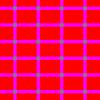|


|

The moon illusion is one of the most famous of all illusions. Stated simply, the full moon, when just above the horizon, appears much larger than when it is overhead. Yet the moon, a quarter of a million miles away from the earth, always subtends the same angle wherever it is in the sky, roughly 0.5 degrees. The first problem is for photographers. A wonderful picture presents itself, with the full moon just rising above a spectacular horizon. Click, the picture is taken. Yet the result is disappointing. The moon seems much smaller in the photograph than it did when viewed with the naked eye. Even professional photographers fall for this one. Yet on a normal lens, 50mm on a 35mm camera, the field of view is around 50 degrees, and the width of the moon, subtending an angle of 0.5 degrees, will be 100th of the width of the photo! Many photographs that you see in magazines, containing both a moon and a landscape, will be composites. The landscape will be taken with a normal lens, the moon taken with a telephoto lens, to get a bigger image. How does this illusion come about? Since the moon always subtends an angle of 0.5 degrees, the image on the retina must always be the same. Clearly the problem is one of interpretation. One simple experiment shows this to be so. A full moon just above the horizon will not appear so large to the human eye if a piece of paper is held up to that eye with a hole in it, so that only the moon can be seen through the hole and not the horizon. If the other eye is open at the same time, viewing both the moon and the horizon, the two eyes will each see different sized moons! e explanation is believed to be as follows. We ’know’ that a cloud that is overhead will be larger than when it moves towards the horizon. And an airplane that is a mere speck on the horizon becomes large when it is overhead. And we are all familiar with standing under a tree which seems enormous, yet at a couple of hundred paces seems insignificant. It would seem that so much of our world is interpreted this way that we are ill-equipped to cope with an object like the moon, that subtends the same angle at the eye, whatever position it occupies in the sky. And so our brain ’interprets’ the image that it ’sees’, and tells us that the moon is larger than it really is. |
||||||||||||||
Home Galleries Galleries Test & Games Test & Games News News Brain Soft Brain Soft About AboutLookMind.com© 2006 | E-mail: allillusion@gmail.com | Privat Policy |















 The Moon Illusion
The Moon Illusion